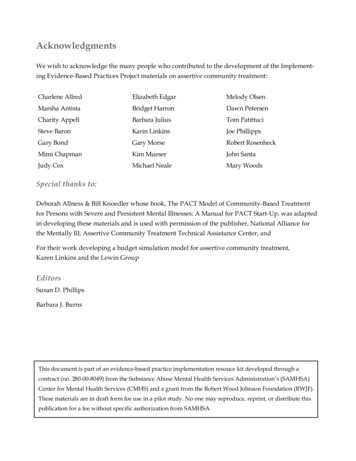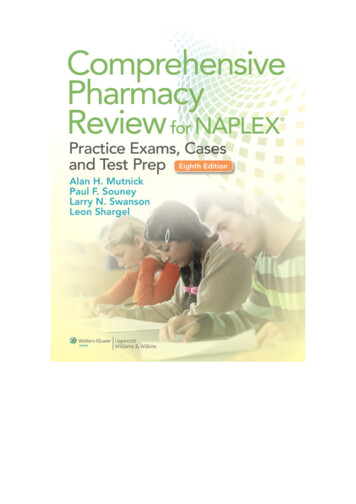
Transcription
AcknowledgmentsWe wish to acknowledge the many people who contributed to the development of the Implementing Evidence-Based Practices Project materials on assertive community treatment:Charlene AllredElizabeth EdgarMelody OlsenMarsha AntistaBridget HarronDawn PetersenCharity AppellBarbara JuliusTom PatittuciSteve BaronKarin LinkinsJoe PhillippsGary BondGary MorseRobert RosenheckMimi ChapmanKim MueserJohn SantaJudy CoxMichael NealeMary WoodsSpecial thanks to:Deborah Allness & Bill Knoedler whose book, The PACT Model of Community-Based Treatmentfor Persons with Severe and Persistent Mental Illnesses: A Manual for PACT Start-Up, was adaptedin developing these materials and is used with permission of the publisher, National Alliance forthe Mentally Ill, Assertive Community Treatment Technical Assistance Center, andFor their work developing a budget simulation model for assertive community treatment,Karen Linkins and the Lewin GroupEditorsSusan D. PhillipsBarbara J. BurnsThis document is part of an evidence-based practice implementation resouce kit developed through acontract (no. 280-00-8049) from the Substance Abuse Mental Health Services Administration’s (SAMHSA)Center for Mental Health Services (CMHS) and a grant from the Robert Wood Johnson Foundation (RWJF).These materials are in draft form for use in a pilot study. No one may reproduce, reprint, or distribute thispublication for a fee without specific authorization from SAMHSA
TA B L E O F C O N T E N T SAbout this workbook1Plan a Group Learning ProcessPrepare Program-Specific InformationPrepare Agency-Specific InformationVisit an Existing TeamArrange for Didactic TrainingRecruit a Mentor or ConsultantInvite the Advisory GroupChapter 1 – Principles of Assertive Community Treatment5ObjectivesComplementary ActivitiesPrinciples of ACTHow did ACT Change the Way Services are DeliveredBenefits of ACT“Active Ingredients”How is ACT Different from Case ManagementHow is ACT Different from Other TeamsHow Does an ACT Team Relate to Other ServicesWho Uses ACT ServicesWho are ‘Consumers in Greatest Need’ReviewChapter 2 –Important conceptsObjectivesComplementary ActivitiesImportant ConceptsRecoveryStress-Vulnerability ModelReview21
Chapter 3- Core Processes33ObjectivesComplementary ActivitiesCore ProcessesOverview of ProcessesEngagementComprehensive AssessmentPsychiatric/Social Functioning History TimelineTreatment PlanningWeekly Consumer ScheduleDaily Team ScheduleDaily Team MeetingOther MeetingsReviewChapter 4- ACT Service componentsObjectivesOverviewMedication SupportPsychosocial TreatmentCommunity Living SkillsSocial Relationships and Leisure ActivitiesHealth PromotionFamily InvolvementHousing AssistanceEmployment59
Tables and FiguresTable 1.1Comparison of Case Management and ACT12Table 1.2Comparison of Team Models15Figure 2.1Stress-Vulnerability27Table 2.1Stressors and Susceptibility to Stress28Table 3.1Principles of Assessment42Table 3.2Elements of a Comprehensive Assessment43Figure 3.1Psychiatric/Social Functioning History Timeline47Figure 3.2Weekly Consumer Schedule50Figure 3.3Daily Team Schedule53Figure 4.1Areas of ACT Services61Appendix A Sample Comprehensive Assessment85Appendix BSample Treatment Plan101Appendix CDartmouth Assertive Community Treatment Scale (DACTS)105AppendicesAppendix D Medication Management Approaches in Psychiatry ImplementationResource Kit Pamphlet: Information for Practitioners and ClinicalSupervisors (DRAFT Evaluaton Edition)Appendix EAppendix F109Illness Management and Recovery Program Implementation ResourceKit Pamphlet: Information for Practitioners and Clinical Supervisors(DRAFT Evaluaton Edition)117Integrated Dual Disorder Treatment Implementation Resource KitPamphlet: Information for Practitioners and Clinical Supervisors(DRAFT Evaluation Edition)120Appendix G Family Psychoeducation Implementation Resource Kit Pamphlet:Information for Practitioners and Clinical Supervisors(DRAFT Evaluation Edition)125Appendix H Planning for Success – Job Support Checklists129Appendix ISupported Employment Implementation Resource Kit Pamphlet:Information for Practitioners and Clinical Supervisors(DRAFT Evaluation Edition)139
About This WorkbookThe Implementing Evidence-Based Practices Project Assertive Community Treatment Workbookwas written to provide the leaders of new assertive community treatment programs a tool for orienting practitioners to the principles and practices of assertive community treatment. This workbook is made up of nine modules. Modules 1 through 4 focus on principles, processes, and practicesspecific to the assertive community treatment approach to service delivery. Modules 5 through 8provide additional information about additional evidence-based interventions that teams use inworking with assertive community treatment consumers and family members: (1) illness management and recovery skills, (2) integrated treatment for dual-diagnoses, (3) supported employment,and (4) family psychoeducation. The content of modules five through eight is taken from materialson these interventions that were developed for the Implementing Evidence-Based Practices Project.Much of the material used in this workbook was adapted from The PACT Model of Community-BasedTreatment for Persons with Severe and Persistent Mental Illness: A Manual for PACT Start-up written byDeborah Allness and William Knoedler and published by the National Alliance for the MentallyIll ACT Technical Assistance Center. This publication, referred to as The PACT Manual, is used byThe Evaluation Center at the Health Service Research Institute in Boston to illustrate characteristicsof a model manual. In preparing the Implementing Evidence-Based Practices materials on assertive community treatment, we consistently found that assertive community programs had usedthis manual in starting their programs and referred to it often. The PACT Manual is a valuable tool,particularly since it was written by people who were involved in the original assertive communitytreatment program. Groups forming new assertive community treatment programs can obtain acopy from the National Alliance for the Mentally Ill ACT Technical Assistance Center via the internet (http://www.nami.org/about/PACT.htm) or by calling (866) 229-6264. The Implementing Evidence-Based Practices Project materials on assertive community treatment are meant as a complementto, but not a replacement for, The PACT Manual.PLAN A GROUP LEARNING PROCESSLeaders of new assertive community treatment programs can use the Assertive Community Treatment Workbook to guide a group learning process. The sense of being part of a team and the abilityof the team to process information as a group and make sense of it together is an essential part ofassertive community treatment. For this reason we suggest a group learning process versus simplygiving practitioners the workbook to peruse on their own.DRAFT 2003ASSERTIVE COMMUNITY TREATMENT WORKBOOK1
P R E PA R E P R O G R A M - S P E C I F I C I N F O R M AT I O NIn addition to the materials in this workbook, team leaders will need to be prepared to provide program staff with information about the specific policies and procedures that pertain to the programbeing implemented. These include: criteria for admitting people to the program the limited conditions under which people will be discharged or ‘stepped down’ to otherservices the assessments team members will complete and the timeframe for completing them the criteria upon which the program’s fidelity to the assertive community treatmentmodel will be assessed the outcomes that will be monitoredP R E PA R E A G E N C Y- S P E C I F I C I N F O R M AT I O NIn addition to the areas addressed in this workbook, team leaders will need to develop a plan fortraining members of new teams about other policies and procedures that may be relevant to theagency in which the team operates. These might include: safety– many agencies with existing community-based programs will have materials re-lated to safety. If training in this area is not already available, the team leader will wantto plan for training in de-escalation techniques. A local law enforcement agency mayalso be able to provide training in personal safety and crime prevention strategies. emergencies–team members must know the procedures to follow if an emergency oc-curs while they are in the community billing procedures– team members will need to know how to document their activitiesand bill for services vehicles–team members need to understand the policies about the use and maintenanceof vehicles mandated reporting–team members must know how to report suspected abuse andneglect consumers’ rights–team members should be aware of State and Federal consumerrights requirements, especially the Americans with Disabilities Act.The human resource office of the agency in which the new program is operating may know of otherprogram, agency, or state policies the staff need to be aware of.DRAFT 2003ASSERTIVE COMMUNITY TREATMENT WORKBOOK2
VISIT AN EXISTING TEAMWe suggest that the staff of new programs visit and observe an experienced assertive communitytreatment team after they have processed the information in this workbook. Being familiar with thematerials in this workbook prior to visiting a team will make the visit more productive. Rather thanthe hosting team having to take time to explain the basics, they will be able to spend time showing the new program staff how the basics are applied in the ‘real world.’ To locate a team to visit inyour area, contact:Assertive Community Treatment Association810 E. Grand River Ave., Suite 102Brighton, Michigan 48116phone: (810) 227-1859email: CheriMSixbey@actassociation.comNational Alliance for the Mentally Ill2107 Wilson Blvd, Suite 300Arlington, VA 22201-3042(866) ttp://www.nami.org/about/PACT.htmARRANGE FOR DIDACTIC TRAININGAfter the staff of a new program have reviewed this workbook and visited an experienced team, theprogram is ready to bring in a trainer. The trainer’s job is to help the team take what they have seenand read and put it into practice. The initial training takes 2-3 days. If help with locating a trainer isneeded, the Assertive Community Treatment Association and the National Alliance for the Mentally Ill can provide you with names of people experienced in training new teams (see contact information on previous page).R E C R U I T A M E N TO R O R C O N S U LTA N TAfter the initial 2-3 day training, the team leader and psychiatrist are responsible for assuring thatthe team follows the assertive community treatment model in their work with consumers. This canbe a challenge. What has to happen is that the team leader has to facilitate a team development process, apply what they have just learned about assertive community treatment in their own clinicalwork with consumers, AND at the same time assure through clinical supervision that team members follow the model.It is very easy to get off track and do something similar to, but not quite the same as, assertivecommunity treatment. Sometimes this happens because teams believe they are diligently followingthe assertive community treatment model, but have missed some of the more subtle aspects of it.In other cases, teams do well at the start, but as more consumers are admitted to the program andDRAFT 2003ASSERTIVE COMMUNITY TREATMENT WORKBOOK3
there is more pressure on the team, they revert to older, more familiar ways of working. To assurethat a new program implements and follows the assertive community treatment model, it is important that new team leaders work with a mentor or consultant throughout the first year of operation.A mentor or consultant can provide ongoing telephone and in person support to help the teamleader with this challenging leadership role.INVITE THE ADVISORY GROUPThe more information members of the team’s advisory group have about assertive communitytreatment, the better they will be able to support the team and its mission. Training is also an opportunity for team members and advisory group members to become familiar with each other. Makesure that the advisory group members and team members are introduced to each other and thatteam members are familiar with the role of the advisory group.DRAFT 2003ASSERTIVE COMMUNITY TREATMENT WORKBOOK4
1ChapterPrinciples of Assertive Community TreatmentOBJECTIVESFamiliarize staff and Advisory Group members with the assertive communitytreatment model.This chapter explains the history of ACT, the outcomes associated with this model, key components, how assertive community treatment compares to case management, and characteristics of thepopulation who receive ACT services.Team members will also need to know specific information about the particular program in whichthey will be working, such as: admission criteria for consumers; criteria upon which the program’s fidelity to the assertive community treatment modelwill be assessed; outcomes upon which the success of the program will be assessed.Staff and Advisory Group members will understand the potential benefits of assertivecommunity treatment.Studies that have explored what makes a difference in whether or not practitioners adopt a newtreatment approach have found that practitioners are more likely to adopt a practice if it addressesan area in which they feel they need to improve. With assertive community treatment, it may not beso much a matter of an individual practitioner needing to improve, but of radically addressing theway services are organized and delivered. Encourage team members to share experiences where thetraditional service delivery system has been inadequate and help them identify aspects of assertivecommunity treatment that address those inadequacies.DRAFT 2003ASSERTIVE COMMUNITY TREATMENT WORKBOOK5
Begin to build a ‘team’The ultimate purpose of this chapter is to have staff begin to think and act like a team. A criticalcomponent of a well-functioning team is open communication. Working through this chapter creates an opportunity to learn about how team members communicate in a team environment. Youwill want to have team members discuss their responses to the questions in this workbook in agroup format.Some people have difficultly speaking up in a group. This might be because they are somewhattimid or soft-spoken by nature. Others may feel professionally intimidated by those with moreexperience or higher degrees. Conversely, some team members will be very self-confident and outspoken and will need to learn to listen openly to what others have to say. One of the leader’s roles isto encourage individuals who are more withdrawn to express their views and make sure that morevocal team members give others an opportunity to speak. There will be an opportunity to assessanxiety that team members may feel about working on an assertive community treatment team.Introduce cross trainingThis chapter introduces cross training by having people begin to think about the professionalknowledge and expertise they have and how it could be of value to other team members.C O M P L E M E N TA RY A C T I V I T I E SIdentify communication stylesThere are a number of exercises that identify differences in the ways people communicate andwork. Often these exercises involve a brief quiz or questionnaire that result in the person beingidentified as some particular ‘type’ of communicator or worker. If you do not have an exercise likethis on hand, check with your Human Resources Officer. If you are still unable to locate an exerciseof this nature, the Myer-Briggs Type Indicator is used for this purpose but requires a person trainedin interpretation of it. A number of adaptations of this are available.The idea behind having your team do an exercise of this nature is to help team members understand their innate differences and to give them a vocabulary for talking about those differences.Ideally, the exercise will include tips on how people with different tendencies can communicate orwork more effectively with other ‘types.’ This can also function as an icebreaker.Have team members take responsibility for presenting materials to the teamOne strategy for using this workbook is to have individuals read the materials and come to a teammeeting prepared to respond to the discussion questions. Another option is to divide this workbookinto sections, then have the team divide into groups with each group taking responsibility for different sections. Ask each group to plan a presentation of the materials for the larger group. Whenthey have finished, discuss the review questions together.DRAFT 2003ASSERTIVE COMMUNITY TREATMENT WORKBOOK6
Write a mission statement or team mottoPart of being familiar with the assertive community treatment model and working as a team is being clear about goals. You might have the group develop a brief mission statement or come up witha one-line motto. Depending on the interests of the group, they might also create a team logo.Learn about consumers’ and family members’ perspectives on mental health servicesWe encourage you to invite a group of 3 to 5 people who have been recipients of mental health services and people who have family members who have been diagnosed with a severe mental illnessto participate in a panel discussion. These might include members of the team’s Advisory Group,consumers working on the team, or people identified through local consumer or family groups.Ask panelists who have experienced mental illness to be prepared to discuss the effect of theirillness on them as a person. Also ask them to share experiences they had with the mental healthsystem that were helpful and those that were not helpful.Ask family members participating in the panel to discuss the experience of finding out their familymember had a mental illness and how their family member’s illness has affected the family. Also,ask them to talk about experiences they have had with the mental health system that were helpfuland not helpful.Have each panelist in turn tell his or her story and then ask the panelists if they would be willing toentertain questions from the team?DRAFT 2003ASSERTIVE COMMUNITY TREATMENT WORKBOOK7
P R I N C I P L E S O F A S S E R T I V E C O M M U N I T Y T R E AT M E N T1. Assertive community treatment is a service delivery model, not a case managementprogram.2. The primary goal of assertive community treatment is recovery through communitytreatment and habilitation.3. ACT is characterized by a: team approach in vivo services small caseload time unlimited services shared caseload flexible service delivery fixed point of responsibility 24/7 crisis availability4. ACT is for people with the most challenging and persistent problems.5. Programs that adhere most closely to the ACT model are more likely to get thebest outcomes.DRAFT 2003ASSERTIVE COMMUNITY TREATMENT WORKBOOK8
H O W D I D A C T C H A N G E T H E W AY S E R V I C E SARE DELIVERED?Assertive community treatment (ACT) began when several mental health professionals at theMendota Mental Health Institute in Madison, Wisconsin realized that many people diagnosed witha severe mental illness were being discharged from inpatient care in stable condition only to returnshortly thereafter. At best, revolving door hospitalizations were accepted as inevitable. At worst,people diagnosed with severe mental illness who did not fair well under the existing system of carewere labeled as ‘noncompliant,’ ‘treatment resistant,’ or ‘unmotivated,’ and their needswent unmet.Rather than finding fault with the people who were not benefiting from existing mental healthservices, the originators of assertive community treatment, Drs. Arnold Marx, Leonard Stein, andMary Ann Test, took a different approach. They looked at the way mental health services weredelivered and created a way to change care so that people diagnosed with a severe mental illnesscould become integral members of the community.What they found was that: following discharge, the variety and intensity of services to support individuals in theirlives outside the hospital decreased dramatically services were invariably clinic-based, and admission criteria and rules about continuingto receive services varied regardless of an individual’s needs, many programs were available only for a limitedperiod and were of no assistance once a person was discharged services were structured in a way that assumed individuals progressed steadily frommore to less structured services without consideration for individual differences in thecourse of recovery if a service was not available, no one was responsible for insuring that individuals gotthe help they needed even when a considerable amount of time was spent in the hospital teaching people theskills they needed to live in the community, these skills did not generalize to communityliving problems with shifting skills into the community were exacerbated by the fact that manypeople diagnosed with a severe mental illness were particularly vulnerable to the stressassociated with change and new experiences.DRAFT 2003ASSERTIVE COMMUNITY TREATMENT WORKBOOK9
The originators responded by designing a service delivery model in which a team of professionals assumed responsibility for providing the specific mix of services each individual needed at theappropriate frequency and intensity and for as long as necessary, and in which team memberswere available 24 hours a day, 7 days a week. Services were provided in vivo, that is, services wereprovided in the community in places and situations where problems arise rather than in an officeor clinic settings. Interventions were integrated through collaboration among team members. Theindividual’s response was carefully monitored so that the team could quickly adjust interventionsto meet changing needs. Rather than brokering services from other providers, team members provided an array of treatment and habilitation support themselves.W H AT A R E T H E B E N E F I T S O F A S S E R T I V EC O M M U N I T Y T R E AT M E N T ?Since the original assertive community treatment (ACT) program began in Madison nearly 30 yearsago, programs have been implemented in 35 states and in Canada, England, Sweden, Australia, andHolland. As assertive community treatment spread, researchers carefully studied its effectiveness.Reviews of assertive community treatment research consistently conclude that, compared withother treatments under controlled conditions (e.g., brokered case management, clinical case management), assertive community treatment leads to a greater reduction in psychiatric hospitalizationand a higher level of housing stability. Research also shows that, compared to other treatments,assertive community treatment has the same or better effect on quality of life, symptoms, and socialfunctioning. In addition, consumers and family members report greater satisfaction.While studies consistently show that assertive community treatment is associated with many beneficial outcomes, the Patient Outcomes Research Team (PORT) made up of researchers from theUniversity of Maryland and Johns Hopkins University found that people who might benefit fromassertive community treatment often do not receive this intervention. Those findings ultimatelylead to the Implementing Evidence-Based Practices Project and the development of materials tohelp mental health systems implement assertive community treatment programs and other interventions known to be effective for adults diagnosed with serious and persistent mental illness.W H AT A R E T H E ‘A C T I V E I N G R E D I E N T S ’ O F A C T ?One of the unique features of assertive community treatment is that the important characteristics ofthis intervention have been delineated. The characteristics of assertive community treatment havebeen translated into program standards to help make certain that programs attempting to replicateassertive community treatment are adhering to the model. An instrument called the DartmouthDRAFT 2003ASSERTIVE COMMUNITY TREATMENT WORKBOOK10
Assertive Community Treatment Scale (DACTS) is available to help teams assess how closely theirprogram is following the Assertive Community Treatment model (See Appendix C). Your teamleader will tell you about how your program will use this instrument.The following briefly describes some of the basic characteristics of assertive community treatment:Team approach – practitioners with various professional training and general life skills workclosely together to blend their knowledge and skills.Small caseload – a team consists of 10 to 12 staff that serve approximately 100 consumers. Thisresults in a staff to consumer ratio of approximately 1 to 10.Shared caseload – practitioners do not have individual caseloads; rather the team as a whole isresponsible for assuring each consumer is receiving the services he or she needs to live in the community and reach his or her personal goals.Fixed point of responsibility – rather than sending consumers to a variety of providers for servic-es, the team itself provides the services each consumer needs. If using another provider cannot beavoided (e.g., medical care), the team is responsible for making certain that the consumer receivesthe services he or she needs.In vivo services – services are delivered in the places and contexts where they are neededTime unlimited services – a service is provided as long as needed, not on the basis of predeter-mined timelinesFlexible service delivery – the team meets daily to discuss how each consumer is doing. The teamcan quickly adjust the services they are providing to be responsive to changes in consumers’ needs.24/7 Crisis services – services are available 24 hours a day, 7 days a week. Team members oftenfind, however, that they can anticipate and head off crises.DRAFT 2003ASSERTIVE COMMUNITY TREATMENT WORKBOOK11
H O W I S A S S E R T I V E C O M M U N I T Y T R E AT M E N TDIFFERENT FROM CASE MANAGEMENT?In an article published in 2001 in the journal Disease Management and Health Outcomes, Bond, Drake,Mueser, and Latimer, leading ACT researchers, compared assertive community treatment with casemanagement models (Table 1.1). They write:Case management has been defined as the “coordination, integration, and allocation of care within limited resources.” ACT is a model of care that provides treatment and rehabilitation in addition to performing case managementfunctions. Although we discuss ACT in the context of case management, it should be noted that ACT is a morecomprehensive service model.The typical goals of case management (e.g., preventing hospitalization, improving quality of life, improving clientfunctioning), as well as some typical case management activities (e.g., service planning, assessment, and advocacy)overlap with those for ACT programs. However, the methods and resources to achieve these ends differ sharply.Unlike ACT, traditional case managers usually broker services (i.e., link consumers to other service providers)rather than intervening directly. Brokered case managers have individual caseloads, typically averaging about 30consumers (sometimes more), and far more circumscribed job duties.ACT also differs conceptually from intensive case management (ICM). One important difference is that ICM hasno single origin. Consequently, unlike ACT, ICM has not achieved clear consensus in its essential ingredients. Onefrequently-mentioned difference between ACT and ICM is that ICM programs do not subscribe to the team approach with shared caseloads and daily team meetings, a difference that has en empirically confirmed in one study.Table 1.1 A Comparison of Case Management and ACTCase Management ProgramsACT Service Delivery ModelCaseloads of 30 or more Staff to consumer ratio of about 1 to 10Services ‘brokered’ from other providers All services provided directly by team membersCase managers have sole responsibility for peopleassigned to them Team members share responsibility for allindividualsChange in intensity of services means change inproviders Type and intensity of services can be variedeasily Team members provide ANY service a personneedsIndividuals may be dropped from the caseload ifthey are ‘noncompliant,’ in jail, or receiving servicessomewhere else Team is responsible for assuring people receiveservices they need even if they are difficult toengage, get arrested, or are hospitalizedIf a case manager quits or goes on vacation,consumers are switched to someone else or do notreceive services If a team member goes on vacation or quits,service plans are continued by other teammembers who are known to the consumer Team discusses changes in individuals’ statusdaily and adjusts treatment as neededIndividuals receive services they need IF the serviceexists, the person meets eligibility criteria, and thereis space in the programTreatment plans updated monthly or less oftenDRAFT 2003ASSERTIVE COMMUNITY TREATMENT WORKBOOK12
HOW IS AN ACT TEAM DIFFERENT FROMOTHER TEAMS?People from multiple disciplines work together on assertive community treatment teams, but it isnot technically a ‘multidisciplinary team.’ Rather, an assertive community treatment team is what isknown as a transdiscdiplinary team. Table 1.2 on page 19 compares transdisciplinary and multidisciplinary teams.One way of thinking about a transdisciplinary team is as a vehicle that blends the knowledge andskills of professionals from multiple disciplines with the goals of service users to surpasses thelimitations of individual disciplines and service programs. It even transcends the typical providerconsumer relationship. Consumers have a decisive voice in what services they receive and the waythey receive them. This model allows providers to deliver a comprehensive and integrated array ofservices to individuals who have complex needs.As a transdisciplinary team, assertive community treatment teams are set up a
About this workbook 1 Plan a Group Learning Process . Appendix E Illness Management and Recovery Program Implementation Resource . illness manage-ment and recovery skills, (2) integrated treatment for dual-diagnoses, (3) supported employment, and (4) family psychoeducation. The cont










